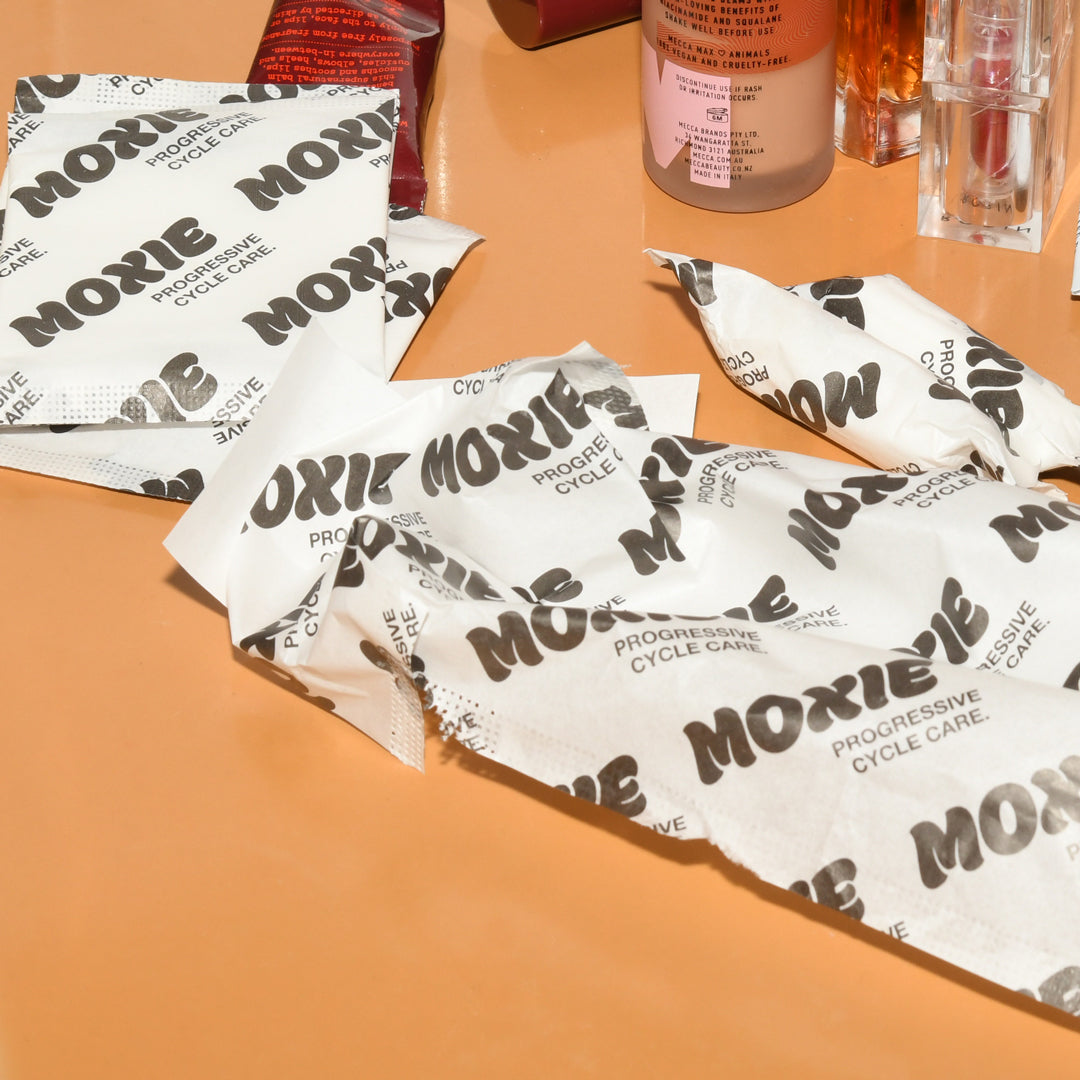Tampon fibre loss: what it is and how to avoid it.

Image by Emma Powers via Dupe.
Ever removed a tampon and noticed it looking a bit... raggedy? That's tampon fibre loss in action – when those tiny absorbent fibres decide to go rogue and stick around after the tampon's gone. While your vagina is basically a self-cleaning marvel, sometimes these little stowaways need a bit of attention.
In this post, we’ll dive into tampon fibre loss, explore its potential health implications, and discuss preventive measures to ensure you stay safe and comfortable during your period. Whether you’re a long-time tampon user or looking for more insight into your menstrual care options, this guide will provide you with the knowledge you need to make informed choices about your cycle.
As always, if in doubt, always get checked out! If you're a tampon user, always be sure to read the label and follow the directions for use in each pack.
WHAT IS TAMPON FIBRE LOSS, A.K.A TAMPON SHEDDING?
Tampon fibre loss (a.k.a tampon fibre shed) occurs when the absorbent fibres of a tampon separate from the tampon itself and remain inside the vagina after removal. To help explain how this happens, think of your tampon a bit like a sweater – with wear, movement and friction, some fibres might start coming loose. This usually happens during insertion or removal, especially if you're using a tampon that's not quite right for your flow, or, if you remove a tampon shortly after inserting it and it hasn't yet absorbed much flow. Using a super-absorbent tampon during a lighter day? That extra friction could be causing more shedding than necessary. This is why it's important to always use the lowest absorbency tampon to suit your flow (more on this a little further on).
WHAT CAUSES TAMPON FIBRE LOSS?
Size and absorbency, material, and usage are all possible contributing factors to tampon fibre loss. Let's break down the main culprits...
MATERIAL MATTERS
Not all tampons are created equal. Synthetic materials like rayon fibres are short and straight, meaning they are more likely to separate from each other, which may lead to fibre shed - unlike organic cotton fibres, which are wavy and long and easily interlock with each other and therefore hold together easier. Some tampons also have an outer cover to help keep the inner core in place, whereas some don't, leaving the inner core exposed - add friction to the mix and this can also add to fibre shed. Having that additional outer layer can help to keep fibres tightly in place.
SIZE MATTERS, TOO
Using a tampon that's too absorbent for your flow is like wearing shoes that are too small – there's going to be unnecessary friction, which may potentially lead to fibre loss and make removal trickier than it needs to be.
TECHNIQUE TALK
We get it – sometimes you're in a rush. But yanking out a tampon like you're starting a lawnmower isn't doing you any favors and can sometimes damage the tampon. Gentle, steady removal is key to keeping those fibres where they belong (this also helps make insertion and removal that extra bit more comfortable).
IS TAMPON SHEDDING DANGEROUS?
While a few lose fibres aren't usually cause for panic, it's worth knowing what to watch out for as retained tampon fibres can create a breeding ground for harmful bacteria within the vagina, increasing the likelihood of infections or other health concerns.
Let's dive a little deeper into those, below.
POTENTIAL HEALTH RISKS OF TAMPON FIBRE LOSS
VAGINAL INFECTIONS
Retained tampon fibres may alter the pH balance of the vagina, which may lead to bacterial vaginosis (BV) or yeast infections. BV, in particular, thrives in environments where the natural balance of bacteria is disrupted, and trapped tampon fibres can contribute to this imbalance.
TOXIC SHOCK SYNDROME (TSS)
In super rare cases, retained fibres could contribute to Toxic Shock Syndrome (TSS), a severe bacterial infection. TSS is caused by the overgrowth of certain bacteria, which can release toxins into the bloodstream. The presence of tampon fibres left behind can create an environment conducive to these bacteria. It's important to practice good tampon hygiene and change tampons regularly to reduce this risk, and always read and follow the instructions in each pack before use.
If you suspect you might have TSS, remove your tampon immediately and see your doctor or go to the ER.
IRRITATION AND DISCOMFORT
If tampon fibres are left behind, they may cause irritation or even pain in the vaginal area. Over time, this can lead to itching, burning sensations, or general discomfort (no thanks).
HOW TO REMOVE TAMPON FIBRES LEFT INSIDE YOU
If you suspect that there may be any tampon fibres left inside you after removing your tampon, insert a clean finger into your vagina and gently trace it around the inner walls and cavity of your vagina to feel for any loose fibres. You should be able to easily grab and remove these (as your vagina isn't very deep) but if not, or if you're concerned in any way, it's important to consult your doctor or go to the ER immediately.
HOW TO PREVENT OR MINIMISE TAMPON FIBRE LOSS
There are some simple steps you can take to help reduce the likelihood of tampon fibre loss and the potential health risks associated with it. Here's how to minimise the fibre drama:
KNOW YOUR FLOW & CHOOSE THE RIGHT ABSORBENCY
Choose tampons that best suit your flow. Light flow? Light tampon. Medium flow? Regular tampon. Heavy flow? Super tampons. Simple as that. Remember, your flow might change throughout your cycle, so don't forget to adjust absorbency accordingly (and switch to pads if your flow isn't heavy enough for a tampon).
OPT FOR QUALITY MATERIALS
Consider choosing organic cotton tampons, and ones that have an outer cover layer designed to make insertion/removal easier and to help keep the inner core fibres in place.
GENTLE DOES IT - PRACTICE PROPER INSERTION & REMOVAL
Insert and remove your tampons gently and with care. Never force a tampon into your vaginal canal, or use one when you don't have your period. When it's time to remove it, do so slowly and carefully to avoid damaging the tampon.
CHANGE REGULARLY
Change your tampon every 4-6 hours, even if it's not totally soaked. Think of it like changing your socks – fresh is best. If your tampon is still dry when you remove it, considering choosing a lower absorbency.
CHECK FOR FIBRE LOSS
After removing a tampon, take a moment to check for any fibres that may have detached during use. If you notice any, try to remove them gently with clean fingers or consider consulting a healthcare professional if they remain inside or if you're worried.
ALTERNATIVE PERIOD PRODUCTS
Tampons are a great option for managing your period flow and can be used 'safely', provided that you properly follow the instuctions in pack (though it's important to undersatnd that there are risks associated with their use, as detailed in this piece and in the leaflets in pack). Though if tampons aren't your thing or if you're looking to make a switch, there are plenty of other options like pads, period cups and even period underwear to help you manage your period - here are a couple of our favourites:
PADS
Worn externally in your underwear, pads absorb period flow without the need for insertion. They come in a variety of absorbencies and materials, making them suitable for different needs. While they may feel bulkier than tampons, pads are convenient, non-invasive, and available in planet-friendly options. Just remember to choose the right absorbency and change them regularly to stay comfortable and help reduce irritation and infection.
MENSTRUAL CUPS
Period peace of mind without the need for fibres. Often made from medical-grade silicone or a similar material, these are little reusable cup-like devices that are inserted into the vagina to collect period flow. You simply insert, remove, rinse and reinsert as you need throughout your cycle (full instructions in pack). Period cups are a great and convenient option for those who want to avoid the risks associated with tampon fibre loss while reducing waste.
Note that period cups still carry the same risks as tampons associated with TSS, though their use has been less associated with it.
FINAL THOUGHTS
While tampon fibre loss isn't usually a major crisis, it's worth paying attention to. Consider the products you're using, choose the right tampon absorbency that best suits your flow, ensure proper insertion/removal, change often and of course, listen to your body - if something feels off, don't hesitate to chat with your healthcare provider. Your vaginal health isn't something to mess around with.
Looking after your body during your period doesn't have to be complicated – it's just about being informed and choosing what works best for you. Whether you stick with tampons or explore other options, the most important thing is finding what makes you comfortable and confident during your cycle.
GOT MORE QNS? JOIN THE CONVO AND OUR COMMUNITY @MOXIEHQ ON TIKTOK
NOTE: just like the discussions had an info provided on TikTok, the information provided here is intended to educate and inform only, and does not constitute medical advice or replace a personalised medical diagnosis from your GP or a medical professional. The aim is to inform and encourage you to get to know your flow and your body, and get checked if things seem off in any way.



